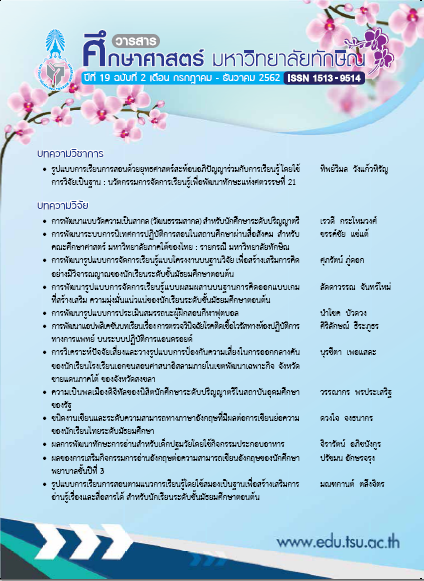ชนิดงานเขียนและระดับความสามารถทางภาษาอังกฤษที่มีต่อการเขียนย่อความของนักเรียนไทยระดับมัธยมศึกษา
Main Article Content
บทคัดย่อ
งานวิจัยนี้มีจุดมุ่งหมายในการศึกษาผลกระทบของชนิดงานเขียนและระดับความสามารถทางภาษาอังกฤษที่มีต่อทักษะในการเขียนย่อความของนักเรียนไทยระดับมัธยมศึกษา กลุ่มตัวอย่างเป็นนักเรียนชั้นมัธยมศึกษาปีที่ 6 จำนวน 90 คนที่ได้มาจากการสุ่มแบบแบ่งชั้น จัดเป็นนักเรียนกลุ่มเก่ง กลางและอ่อน นักเรียนแต่ละคนเขียนย่อความจากการอ่านบทอ่าน 2 ประเภท คือแบบพรรณนาโวหารและ แบบที่กล่าวถึงปัญหาและแนวทางแก้ไข เครื่องมือวิจัยประกอบด้วย บทอ่าน2 บทอ่านและเกณฑ์การให้คะแนนที่ผู้วิจัยสร้างขึ้นในการตรวจการย่อความ 4 ด้าน 1.ด้านความสมบูรณ์ของใจความ 2.ความถูกต้องของใจความ 3.การถอดความด้วยคำพูดของตนเอง 4.คุณภาพโดยรวมของข้อความที่ย่อมา สถิติที่ใช้คือ การวิเคราะห์ความแปรปรวนสองทาง ผลการวิจัยพบว่า 1. ไม่มีความแตกต่างอย่างมีนัยสำคัญของประเภทบทอ่านที่มีต่อคุณภาพของการย่อความ 2. นักเรียนกลุ่มเก่งมีทักษะในการย่อความมากกว่านักเรียนกลุ่มกลาง และนักเรียนกลุ่มกลางมีทักษะในการย่อความมากกว่านักเรียนกลุ่มอ่อน 3. ไม่มีความสัมพันธ์ของปัจจัยประเภทบทความและปัจจัยความสามารถของนักเรียน 4. การย่อความของนักเรียนกลุ่มเก่งดีกว่ากลุ่มกลางและกลุ่มอ่อน กลุ่มเก่งเขียนย่อความได้ใจความสำคัญมากกว่าแต่ยังมีทักษะในการใช้ภาษาของตนเอง ไม่เพียงพอ กลุ่มกลางมักเขียนย่อความโดยนำข้อความที่ไม่สมบูรณ์หรือเขียนใจความที่ไม่ถูกต้องและเขียนรายละเอียดปลีกย่อย ส่วนกลุ่มอ่อนขาดทักษะการย่อความ ควรได้รับการฝึกอ่านจับใจความสำคัญ การหาใจความหลักและใจความรอง รวมวิธีเขียนข้อความตามโครงสร้างที่เหมาะสม ผลของงานวิจัยครั้งนี้สามารถนำไปใช้ในออกแบบการสอนทักษะการเขียนย่อความจากการสอนอ่านจับใจความ รวมทักษะการเขียนต่างๆ และสามารถทำวิจัยซ้ำกับกลุ่มตัวอย่างอื่นเพื่อประโยชน์ในการพัฒนาการสอนการเขียนและการอ่านสำหรับนักเรียนไทยต่อไป
Article Details
ในกรณีที่กองบรรณาธิการ หรือผู้เชี่ยวชาญ ซึ่งได้รับเชิญให้เป็นผู้ตรวจบทความวิจัย หรือ บทความทางวิชาการมีความเห็นว่าควรแก้ไขความบกพร่อง ทางกองบรรณาธิการจะส่งต้นฉบับให้ ผู้เขียนพิจารณาจัดการแก้ไขให้เหมาะสมก่อนที่จะลงพิมพ์ ทั้งนี้ กองบรรณาธิการจะยึดถือความคิด เห็นของผู้เชี่ยวชาญเป็นเกณฑ์
เอกสารอ้างอิง
Chinnawongs, Supanee. (2000). A Study of the Writing Ability of EAP Science Students. Chulalongkorn University Language Institue. Chulalongkorn University.
Cohen, D. A. (1994). Assessing Language Ability in the Classroom. (2nded.). Boston: Heinle & Heinle
Publishers.
Corbeil, G. (2000). Exploring the effects of first- and second-language proficiency on summarizing in
French as a second language. Canadian Journal of Applied Linguistics, 3(1-2), 35-62
Cohen, A., & Upton, T. (2006). Strategies in responding to the new TOEFL reading tasks. NJ:ETS.
Devine, J. (1993). The relationship between general language competence and second language
reading proficiency: Implications for teaching. In P.L. Carrell, J. Devine, & D.E. Eskey (Eds.),
Interactive approaches to second language reading (pp.260-277). Washington, DC: TESOL.
Hinton, R. P., Brownlow, C., Mcmurray, I., & Cozens. B. (2004). SPSS Explained. New York:
Routledge.
Huhta, A., & Randell, E. (1995). Multiple-choice Summary: A Measure of Text Comprehension. In A.
Cumming & R. Berwick (Eds.), Validation in Language Testing. (pp.94-110). Avon: Cromwell.
Johns, A. M. ( 1985). Summary protocols of “underprepared” and “adept”. university students:
replications and distortions of the original. Language Learning 35: 495-517.
Johns, A. M., & Mayes, P. (1990). An analysis of summary protocols of university ESL students.
Applied Linguistics 11, 3: 253-271.
Kobayashi, M. (2002). Methods effects on reading comprehension test performance: text organization
and response format. Language Testing 19, 2: 193-220.
Koda, K. ( 2005). Insight into Second Language Reading : A Cross-Linguistic Approach. Cambridge:
Cambridge University Press.
Muijs, D. (2004). Doing quantitative research in education with SPSS. London: Sage Publications.
Riley, L.G., & Lee, F.J. (1996). A comparison of recall and summary protocols as measures of second
language reading comprehension. Language Testing 13, 2: 173-189.
Sawaki, Y. (2005). A comparison of summarization and free recall as reading comprehension tasks in
Web-based assessment of Japanese as a foreign language. Doctoral Dissertation. University of
California.
Shi, L. (2004). Textual borrowing in second-language writing. Written Communication, 21(2):
171-200.
Tests Document Readability. (n.d.). Readability Calculator. Retrieved From
https://www.online-utility.org/english/readability_test_and_improve.jsp
Urquhart, S., & Weir, C. (1998). Reading in a Second Language: Process, Product, and Practice.
Essex: Pearson Education Limited.
Weir, C.J., Huizhong, Y.,& Yan, J. (2000). An empirical investigation of the componentiality of L2
Reading in English for academic purposes. Cambridge: Cambridge University Press.
Wolf, D.F. (1993). A comparison of assessment tasks used to measure FL reading comprehension.
Modern Language Journal 77, 4: 473-489.
Yamada, K. (2002). Comparison of Two Summary/Text-Integration Writing Tasks Requiring Different
Inferential Processes. RELC Journal, 33: 142-156.
Yu, G. (2008). Reading to summarize in English and Chinese: A tale of two languages? Language
Testing, 25: 521-551.


